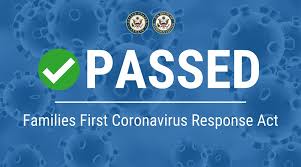Families First Coronavirus Response Act

Last night, the President signed into law the Families First Bill, which passed both the House and the Senate. The bill makes provisions intended to help with the growing COVID-19 / Coronavirus pandemic, including subsidies for food assistance and defense. Some sections of the bill specifically apply to employment, and impose new requirements for employers. These are the major changes with respect to the relationship and obligations between employers and employees:
- Section E of the bill requires employers with less than 500 employees to provide paid sick time to employees who are unable to work or telework for the following reasons:
- A Federal, State, or local quarantine or isolation order related to COVID-19;
- An employee being advised by a health care provider to self-quarantine due to concerns related to COVID-19;
- An employee experiencing symptoms of COVID-19 and seeking a medical diagnosis;
- An employee caring for an individual who is quarantined or who is experiencing symptoms of COVID-19 and seeking a medical diagnosis; or
- An employee caring for a son or daughter under the age or 18 whose school or child care facility has been closed due to COVID-19, or whose regular childcare provider is unavailable due to COVID-19.
- If an employee needs leave for any of the reasons above, a full-time employee is entitled to 80 hours of paid leave and a part-time employee is entitled to leave for the number of hours normally worked over a 2-week period.
- This leave shall be paid at the employee’s normal rate of pay, up to $511 per day and $5,110 total, if the leave is for any of the first three reasons listed above.
- Leave shall be paid at a rate of at least two-thirds the employee’s normal rate of pay, up to $200 per day and $2,000 total, if the leave is for either of the last two reasons listed above.
- If the employee’s normal rate of pay is below minimum wage, minimum wage shall be used instead.
- This paid leave is available to all employees, regardless of how long they have worked for the employer.
- An employer who is part of a multi-employer collective bargaining agreement may satisfy its obligations under this act by contributing to a multi-employer plan.
- An employer may not require an employee taking leave under this act to find a replacement for the leave taken or to exhaust other available paid time off before using this leave.
- It is illegal for an employer to discharge, discipline, or in any way discriminate against an employee for taking leave under the act or filing a complaint under the act.
- A violation of Section E shall be considered a violation of the Fair Labor Standards Act (“FLSA”), and the same remedies will be available (including liquidated damages and attorney fees.)
- Employers are required to post notice of their employees’ rights under this act. Model notice will be available from the Department of Labor by 3/25/2020.
- Employers can require employees to follow reasonable notice procedures after the first day of leave taken under the act in order to continue to receive paid leave.
- The Secretary of Labor has the authority to exclude health care providers and emergency responders from the definition of “employer” under this act.
- The Secretary of Labor has the authority to exempt small businesses with fewer than 50 employees from the requirement of paying for time off ONLY for reason 5 above, to care for a child whose school or child care is unavailable because of COVID-19.
All of the above covers up to 2 weeks / 10 working days of leave, and is enforced as if it were part of the Fair Labor Standards Act. The new bill also has a Section C, which has additional paid leave requirements and is enforced as if it were part of the Family and Medical Leave Act (“FMLA”):
- Section C, which is considered a temporary amendment / supplement to the FMLA, allows for the first 10 days of leave to be unpaid. HOWEVER, these days would most likely be paid under Section E as described above.
- An employee may elect to substitute other paid leave time that is available for these first ten days. As an example, if an employer has a waiver or an employee would be entitled to less than his regular rate of pay due to taking leave to care for a child whose school has been closed, the employee has the right to opt to use available paid vacation time instead.
- An employer with less than 500 employees shall provide paid leave for each day of leave that an employee takes, after the first 10 days, as follows:
- The number of hours an employee would normally work, or based on an average of the last 6 months;
- An amount of at least two-thirds of the employee’s regular rate of pay.
- The leave shall not exceed $200 per day, or $10,000 total.
- The ONLY qualifying reason for leave under this act is if the employee is unable to work or telework due to a need for leave to care for a son or daughter under 18 because the child’s school or place of care has been closed, or the child care provider is unavailable due to a public health emergency.
- Employees can be required to provide notice, as is reasonably foreseeable, to be entitled to paid leave.
- In general, an employee must be returned to their position after taking leave, with exceptions for employers with less than 25 people where the position was eliminated, in which case the employee must get an equivalent position with equivalent or better pay.
- Employees are only eligible for paid leave under this act if they have been employed for at least 30 days by the employer.
- In the event of a multi-employer collective bargaining agreement, employers can satisfy the pay requirements by paying in to a fund for paid leave.
- The Secretary of Labor has the authority to exclude health care providers and emergency responders from the definition of “employer” under this act.
- The Secretary of Labor has the authority to exempt small businesses with fewer than 50 employees if it would jeopardize the viability of the business as a going concern.
- Employers are required to inform their employees of a right to such leave if it is available.
- As an expansion of the FMLA, this is limited to 12 total weeks of leave. Since the first two weeks are unpaid, this allows for up to 10 total weeks of paid leave.
Notably, the additional leave provisions are ONLY for caring for a child whose school or child care is unavailable for a COVID-19-related reason. While an employee may be eligible for traditional FMLA leave for other COVID-19-related reasons, the leave need not be paid under these rules.
This new law takes effect 15 days after enactment, which was March 18, 2020.


